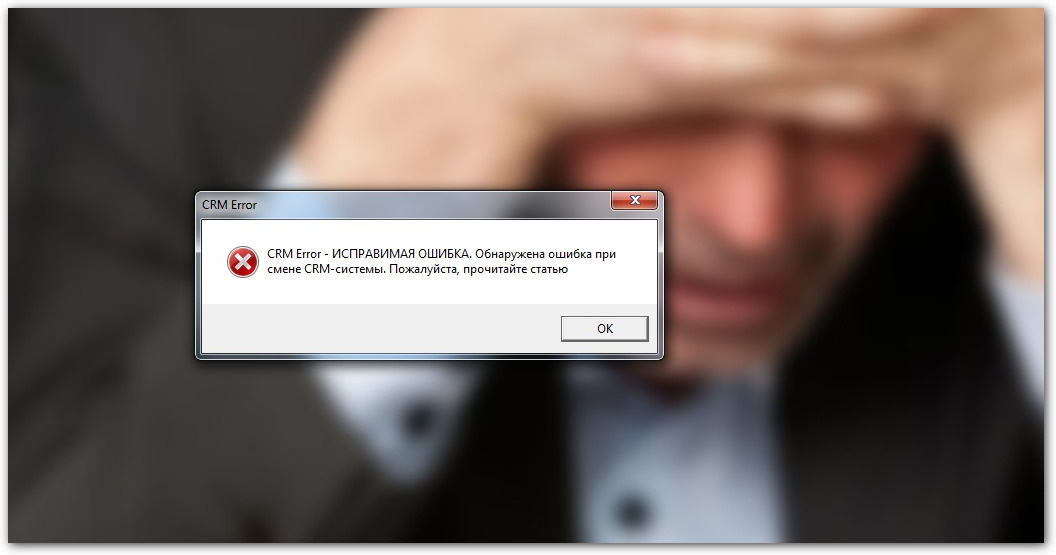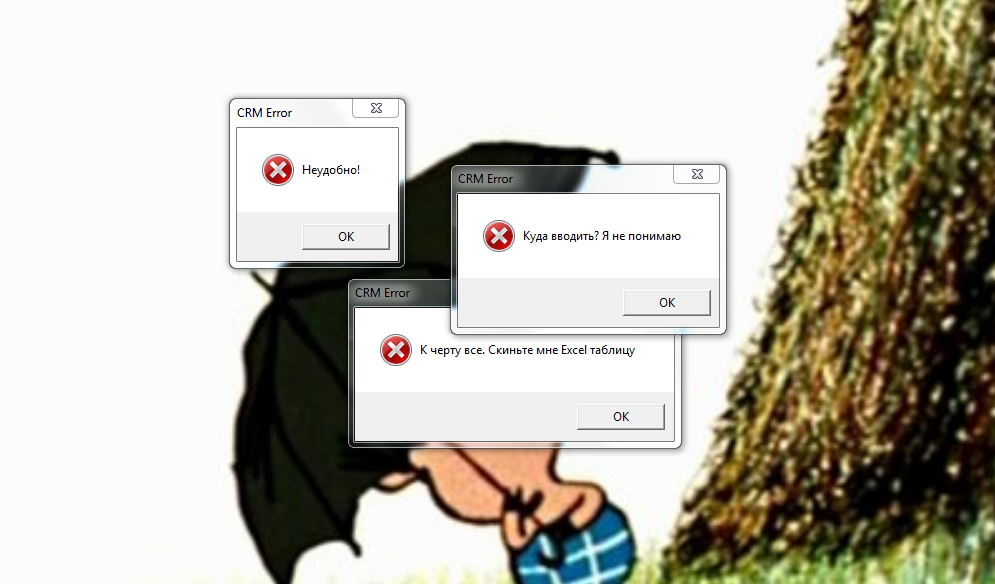How to avoid mistakes when changing CRM

For five years of experience with CRM-solutions in companies, I came across instances when companies outgrow the functionality of closed-source systems. In such situations, they always try to find an alternative, and, more often, the end point is a platform solution: the system is developed from ready-made configurations that are already customized to the desired business specifics.
It often happens that a new system is initially developed incorrectly, that errors are missed even at the stage of the TOR. As a result, the company suffers unpleasant losses, and in order not to get off the rails finally - they return to the old CRM.
In this article, we will analyze the main errors when leaving Saas solutions for development on the platform, as well as the ways in which these errors can be avoided altogether.
Where do the problems begin
If a business has a good potential for scaling, and work has begun with a boxed system, then consider that the problems have already begun. Subsequently, without personalizing the system for the specifics of the business, the most interesting begins.

')
Obviously, getting staff to use an uncomfortable system voluntarily is very painful. The reason for the inconvenience is not only in the interface - the main problem, again, is in the specifics. There are no identical companies, therefore, if the system does not take into account your peculiarities - you will not be able to automate the routine of processes, or receive the necessary information in the right form - this will entail losses.
Therefore, when the system is not adapted to the specifics of the business, employees begin to look for alternatives, and over time this search gradually goes into something else, filling the database in CRM just for a tick.

If you manage to detect a hidden spring in time, consider yourself lucky; this is usually difficult to notice, while a company’s money leak in such work is much more than just the monthly tariff of the system, which in this case plays the role of a task list with customer cards.
Further, when the problem is accepted and clearly marked, and also the reasons for its occurrence are known - the company faces a choice: whether to choose another box solution, a configuration on the platform, or develop a system from scratch.
What will cause more damage when leaving the new system
Perhaps the most senseless costs will occur as a result of the transition "from box to box." In order to save, some companies may find an alternative to the old system: a larger system is already solving all current business problems.
At first glance, this is beneficial - no need to spend money on development, the minimum period of adaptation of staff, a lot of ready-made solutions and automation methods. Yes, in general, everything is super - but you need to understand that if you do not have a studio of several photographers, you will grow, and this transition will only delay the inevitable repetition of the story.
How to avoid these costs
The most effective way to not drain the budget for perpetual jumping from system to system is to initially place a business in a fully customizable system. However, if you have already run into the box and put your business there - then we will figure out how and why to get out of it, as well as consider the platforms on which it is most convenient to develop the system.
It is important to understand that this option, again, is not relevant for everyone. There are a lot of examples of when a business is not growing: for example, some group of elite designers who carry out expensive orders and work on word of mouth for very, very fat customers. They do not want to grow, they are comfortable being small - so they are ready to exist for years.
But if your company gets bigger, it would be nice to get off on the platform in time, because such a system will develop along with your business, otherwise you will get the same glass ceiling.
The same goes for development from scratch. You can hire a development team - but they can be lured into a more profitable project; or, the team may fall apart due to internal contradictions. There are many such examples, when developing from scratch, there are organizational or architectural difficulties - when the architecture of the project was laid initially incorrectly. The system can be constructed in such a way that at a certain moment it will become un-developed or very slow.
The way out of these difficulties can be the right choice of platform, and it’s really hard to decide.
What to look for when choosing a platform
When choosing, pay attention to how much you are dependent on the developer. If using a platform solution there is an opportunity for independent work without any programming skills, then the platform is “real”. That is, what is important is how “alienable” the platform itself: you took it and went to work; took the documentation - and you can not contact the supplier. At all.
There are solutions that use known languages: SQL, VBS, JS. And there are those who invent "your pascal." The more well-known built-in scripting platforms and languages, the more independent you are from the vendor. For example, you can develop a system simply by hiring any student of the programmer's faculty. Together with a business analyst or a person who is easily guided in all your business processes - an ordinary student can safely perform the work of vendor developers, who usually take a lot of money for an hour of their work (depending on the openness of the system).
Another very important point is prototyping. Being able to put on a quick prototype system for testing is really cool. With this tool, you check your hypotheses and will know exactly how to formulate the TOR without errors.
Briefly consider several vendors:
If you take, for example, "1C" - you can develop the system only by a certified programmer. This option is suitable for those who do not want to risk quality, and is willing to regularly invest in the improvement of the system and its support. Fortunately, there are a lot of 1C specialists on the market, so the configuration and maintenance of the system can not cause any problems.
About Terrasoft, we can say that in general this system is a very high-quality designer with powerful customization capabilities, which is perhaps one of the most important characteristics for the platform. Among the shortcomings are the cost of tariffs, and some not very pleasant features of payment for customer support.
The visual editor of the “Click” platform is well implemented: it allows you to make a prototype for testing before starting work with the system. The degree of configuration of all components without programming is extremely high, which is also nice, especially for the cost savings on developing a system for your business.
How to prepare for the transition to the platform
1 - Find the "ideologue"
You need a person who can accurately reflect the current business processes of the company and formalize them. This person will control the entire development process taking into account the convenience of users, and constantly check with the "map" - directing the project in the right direction.
2 - Create a prototype
Even those companies that have experienced inefficient box systems can not always formulate certain tasks to the new system. This is the risk associated with the fact that when you create a new CRM project, you can lay errors in advance, already at the level of the TOR. Therefore, debugging will be an important point here - that is, you should not only build a test model, but also try it out in practice. If the visual editor of the platform allows you to distribute the first working version - be sure to use this opportunity and play with the prototype together with a business analyst. This will reduce the many design mistakes you could make.
3 - Get rid of the vendor
Quite a controversial point, which is not suitable in all situations, but will help to significantly reduce investment in the system. The trick is that if you use a truly adaptive platform, it will be much more profitable for you to hire a freelancer, and set up the system on your own separately from the vendor developers.
4 - To train employees
If the business has grown out of the system, it’s enough to explain to the employees: “Guys, we have grown up, let's move on to the new system.” In this case, using the platform, you can prepare the system interface so that it looks like the old one - this will reduce the discomfort from the transition. The greater the convenience of users, the easier the system will take root.
Conclusion
Platforms allow businesses to grow, because such a system develops with the company that uses it. Any changes in business are put on the platform - you change the system precisely in terms of convenience: analysts, those who enter, those who make any decisions.
To avoid major losses, you need to initially implement the platform. Here the key point is that it was with minimal participation of developers. Yes, of course, you can use the developer, it will be to some extent convenient and healthy - but reducing the risk here happens if you can develop this platform yourself, without any special knowledge and developer - this is the key.
There are a lot of platforms on the market that say: “We can do everything, we will do everything for you, we have a platform! What we need, we will program everything for you, ”but the true platform is only the system that can exist, function and develop by the forces of a client, dealer, that is, without a developer.
Source: https://habr.com/ru/post/335262/
All Articles